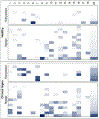Viruses associated with ill health in wild chimpanzees
- PMID: 35015311
- PMCID: PMC8853648
- DOI: 10.1002/ajp.23358
Viruses associated with ill health in wild chimpanzees
Abstract
Viral infection is a major cause of ill health in wild chimpanzees (Pan troglodytes), but most evidence to date has come from conspicuous disease outbreaks with high morbidity and mortality. To examine the relationship between viral infection and ill health during periods not associated with disease outbreaks, we conducted a longitudinal study of wild eastern chimpanzees (P. t. schweinfurthii) in the Kanyawara and Ngogo communities of Kibale National Park, Uganda. We collected standardized, observational health data for 4 years and then used metagenomics to characterize gastrointestinal viromes (i.e., all viruses recovered from fecal samples) in individual chimpanzees before and during episodes of clinical disease. We restricted our analyses to viruses thought to infect mammals or primarily associated with mammals, discarding viruses associated with nonmammalian hosts. We found 18 viruses (nine of which were previously identified in this population) from at least five viral families. Viral richness (number of viruses per sample) did not vary by health status. By contrast, total viral load (normalized proportion of sequences mapping to viruses) was significantly higher in ill individuals compared with healthy individuals. Furthermore, when ill, Kanyawara chimpanzees exhibited higher viral loads than Ngogo chimpanzees, and males, but not females, exhibited higher infection rates with certain viruses and higher total viral loads as they aged. Post-hoc analyses, including the use of a machine-learning classification method, indicated that one virus, salivirus (Picornaviridae), was the main contributor to health-related and community-level variation in viral loads. Another virus, chimpanzee stool-associated virus (chisavirus; unclassified Picornavirales), was associated with ill health at Ngogo but not at Kanyawara. Chisavirus, chimpanzee adenovirus (Adenoviridae), and bufavirus (Parvoviridae) were also associated with increased age in males. Associations with sex and age are consistent with the hypothesis that nonlethal viral infections cumulatively reflect or contribute to senescence in long-lived species such as chimpanzees.
Keywords: chimpanzee; conservation; disease; health; metagenomics; virus.
© 2022 Wiley Periodicals LLC.
Conflict of interest statement
Conflicts of interest
The authors declare they have no conflicts of interest.
Figures



References
-
- Agresti A, & Coull BA (1998). Approximate is better than “exact” for interval estimation of binomial proportions. The American Statistician, 52(2), 119–126. 10.1080/00031305.1998.10480550 - DOI
Publication types
MeSH terms
Grants and funding
LinkOut - more resources
Full Text Sources

